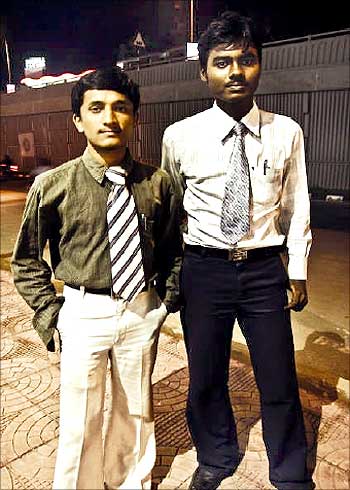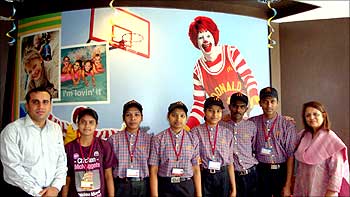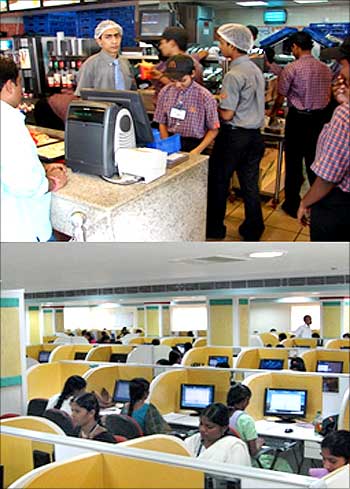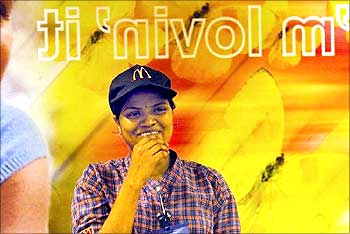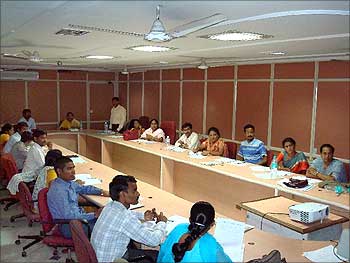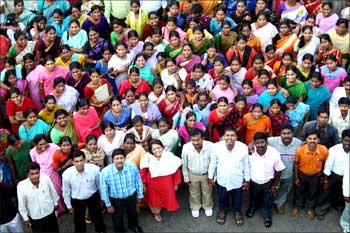 | « Back to article | Print this article |
From poverty to good jobs: EGMM makes it possible!
Two years ago Shekar Nalla from a small tribal village in Andhra Pradesh was down and out: poor, unemployed and ostracized. His poverty-stricken family faced an uncertain future. But now his life has changed all together.
Employed with an insurance company in Hyderabad, he now earns Rs 120,000 per annum. The society that ostracized them, respects him and his family today. He is among 200,000 youngsters in Andhra Pradesh who have got a livelihood, thanks to a programme called Employment Generation and Marketing Mission (EGMM). EGMM is a unique public private partnership venture that trains poor rural youth take up jobs, helping them earn between Rs 3,000 and Rs 10,000 a month.
These enterprising youngsters are making their mark in the new-found opportunities in around 60 companies like HDFC Bank, Hindustan Unilever, Reliance Industries, Spencer's, ITC Agri, Barclays, Aegis, Tata Teleservices, Vodafone, Airtel, Reliance Telecom, Future Group, et cetera, to name a few .
"The Mission has been able to conduct training for over 250,000 people across Andhra Pradesh since inception. Most of the villagers who are indebted to moneylenders for life, have now got a new lease of life, says Meera Shenoy, executive director, EGMM. Click NEXT to read further. . .
From poverty to good jobs: EGMM makes it possible!
The initiative is gaining momentum as its main stakeholders -- the government, the private sector, and the women self-help groups -- work closely towards a common cause. It is transforming the lives of rural youth and empowering them to take up challenges in a competitive environment.
The training is offered free of cost to the rural unemployed youth. The government has hiked the budget for training from Rs 10 crore (Rs 100 million) in 2005-06 to Rs 100 crore (Rs 1 billion) in 2007-08.
"This is a win-win situation for all the stakeholders. Without spending much, the government is able to create an alternative jobs pool. In a span of three months, we are able to train the youth. For the poor, one job has taken away all the stigma that dogged them all along. And for corporates, these youth have turned out to be loyal and productive employees," says Meera Shenoy.
The EGMM's goal is to offer one job for every poor family. Meera Shenoy shares her experience of transforming the lives of the rural youth. Read on. . .
From poverty to good jobs: EGMM makes it possible!
How does the training work?
Depending upon the qualification and aspiration of the youth and industry's requirements, they are trained. If there are illiterate, they are trained to work in construction and textiles sector.If they are educated (those who have failed in the 10th standrad to those who are graduates), they trained to be employed in the services sector. Among the enrolled, about 50 per cent of the youth work in the services sector.
The EGMM has set up a Rural Retail Academy; a English, Soft Skills and Computers Academy; a Security Academy, etc and has customised trainings linked to new investments like rural BPOs and manufacturing.
The training courses are made by industry experts after understanding the market requirements tailored for the poor. The teachers are trained to teach them in a short span of three months, taking into consideration the requirements of the companies.
From poverty to good jobs: EGMM makes it possible!
How many people get employed after the training?
We have trained about 250,000 youth so far. On an average 75 per cent of the trained people get jobs immediately. From this, 45 per cent are girls and 35 per cent belong to scheduled castes and scheduled tribes (SC/ST). Our data is very accurate as compared to other NGOs.
Our IT architecture works on the basis of transactions and data from the training centres. We are training village communities to monitor the programme. Every month we get a report from the block and district levels. We send these reports -- based on 7 indicators -- to the district collectors to make a comparison with different districts.
This system makes it easier for us to monitor companies that don't pay well. We blacklist such firms.
This year we have also devised a grading system for teachers and students.
From poverty to good jobs: EGMM makes it possible!
Big challenges?
When you do anything new, many don't believe you. So we have had to make it succeed. With the programme succeeding, everything is now demand-oriented, but getting human resources is a big challenge.
Getting the government and the private sector together is difficult too, because the government thinks the private sector is exploitative, while companies feel that it is better not to deal with the government.
It is tough to get the youth to attend these training programmes. They have attended several programmes in the past which were not market-linked, so these youth do not have a job. Disillusioned, they do not want to go through another training session. So we have people who go around and motivate the youth to join our training programmes.
Though ours is one of the largest programmes of its kind, it is just a drop in the ocean. A lot more needs to be done. We need to have over one billion fire flies to make India move in the right direction and sparkle as it ought to. We must learn to be generous, extend help in every possible way and get out of the 'vicious cycle of wealth' to help others.
From poverty to good jobs: EGMM makes it possible!
How many people are involved in the training?
We have a large number of people from the community as it is a huge task to identify and motivate the youth to come forward for the training. We have about 300 people who are working at the village level, besides locally hired trainers.
Are they being recruited by the government? How is the response from private companies?
Everyone longs for a government job. But unfortunately there are no government jobs. Initially, the private sector was very apprehensive about hiring rural youth.
All companies go by the magic word of 'MBAs'. So they thought it was not worth recruiting these youth. But today they have realised that this pool can be loyal. So the attrition rate is reduced and productivity levels are high.
From poverty to good jobs: EGMM makes it possible!
How the EGMM works
The EGMM is four-and-a-half-years old. It has an executive committee headed by the rural development minister, senior government officers and private sector officials.
In terms of programmes, strategy and budgeting, the EGMM has a private sector team at the state level. We work closely with government officials to implement the training programme.
We have 2-3 people in each district and we also have people from the community -- called 'job resource persons' -- who motivate the youth to come to the training classes.
